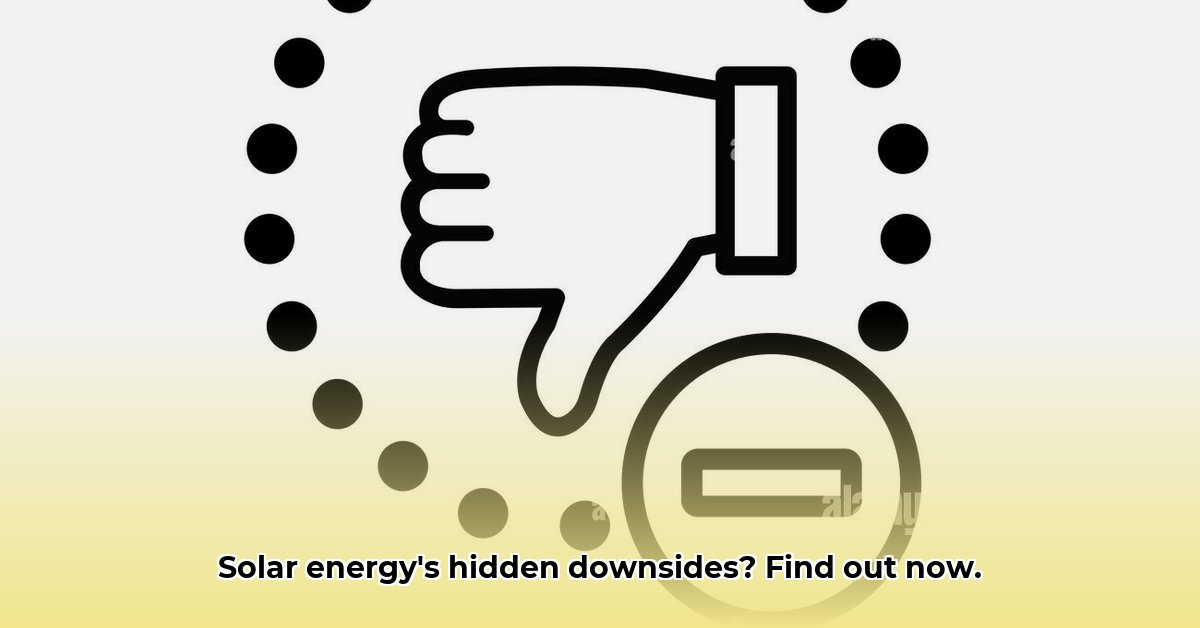Solar power: it sounds amazing, right? Free energy from the sun! But, like anything, it’s not perfect. There are some real downsides to using solar energy on a large scale that we need to talk about. This article will look at the biggest problems – the costs, the technical challenges, and even the environmental impacts of making and using solar panels. We’ll explore why solar energy isn’t always reliable, how expensive it can be, and what we’re doing to fix these issues. By the end, you’ll have a better understanding of the whole picture, seeing both the promise and the challenges of solar power. For more on solar drawbacks, see this helpful article: [Solar energy downsides](https://txgenco.com/what-are-two-drawbacks-of-solar-energy).
Understanding the Disadvantages of Solar Energy
Let’s be honest: solar power sounds amazing. Free, clean energy straight from the sun! But like any technology, it’s not a perfect solution. There are some pretty significant downsides we need to understand before we go all-in on solar. This isn’t about dismissing solar; it’s about having a realistic view of its potential and limitations. Let’s delve into the real-world disadvantages that often get glossed over.
Technical Hurdles: Tackling Intermittency and Storage Challenges
One of the biggest hurdles is that the sun doesn’t always shine. Solar panels only work when sunlight hits them. Cloudy days, nighttime, and even shadows from trees can dramatically cut power production. This inconsistency means you need a backup power source – like the electricity grid – or a battery system to store energy for when the sun isn’t cooperating. Think of it like having a generator for backup power during storms. These backup solutions add considerable cost and complexity. Plus, those battery systems themselves aren’t without problems. They can be expensive, have limited lifespans, and their manufacturing and disposal can raise environmental concerns.
Consider the impact of geographical location; areas with persistent cloud cover, such as the Pacific Northwest in the US or certain regions of Northern Europe, face inherent limitations in solar energy production. The intermittency problem is further compounded by seasonal variations in sunlight hours, particularly in higher latitudes. Overcoming these challenges is key to making solar a truly reliable energy source.
Scientists are hard at work on better batteries, but we’re not quite there yet. Solid-state batteries, for example, promise higher energy density and improved safety compared to traditional lithium-ion batteries, but their widespread adoption is still years away. Furthermore, advancements in grid management technologies, such as smart grids and demand response systems, can help to better integrate intermittent solar energy into the overall power supply. How can we make solar reliably generate power 24/7, regardless of location or weather?
Economic Realities: Examining Upfront Investments and Long-Term Costs
Solar power isn’t cheap – at least, not initially. While the price of solar panels has dropped significantly in recent years, setting up a complete system – including panels, installation, inverters (to convert DC power to AC), and a battery system – is still a pretty hefty investment. It’s like buying a new car; you’re making a large upfront payment. And the costs don’t stop there. You’ll have ongoing maintenance expenses, potential repairs, and eventually, you’ll need to replace the panels after about 25 years. The total cost over the system’s lifetime can be substantial.
The initial investment can range from $15,000 to $25,000 for a typical residential system, depending on the size of the system and local labor costs. Inverters, which typically need to be replaced every 10-15 years, can cost several thousand dollars. Battery storage, while increasing energy independence, adds another significant expense, potentially doubling the initial system cost.
Whether it’s a worthwhile investment depends on many things, including how much sunshine you get and government incentives available in your area. Some folks might get a rapid return, while others might take a longer time to see the financial benefits. Government subsidies and tax credits, such as the federal solar tax credit in the United States, can significantly reduce the upfront cost, but these incentives are subject to change. Factors such as net metering policies, which allow homeowners to sell excess solar energy back to the grid, also influence the overall economic viability of solar. Does the long-term return justify the initial investment for most homeowners, particularly considering the potential for technological advancements that could make current systems obsolete?
Environmental Footprint: Managing Manufacturing’s Impact to Safe Disposal
Manufacturing solar panels isn’t exactly a walk in the park, environmentally speaking. They often require rare earth minerals, and the manufacturing process itself uses a lot of energy and can produce hazardous waste. This means greenhouse gas emissions and the disposal of dangerous byproducts. And even though solar energy is clean once it’s generating electricity, we need to think about the whole life cycle. What happens when those panels wear out? Currently, the recycling infrastructure for solar panels isn’t up to the task, meaning many end up in landfills—a growing problem.
The production of solar panels involves the use of toxic materials such as cadmium telluride and lead. Mining these materials can lead to habitat destruction and water pollution. The manufacturing process also consumes significant amounts of energy, often derived from fossil fuels, which contributes to greenhouse gas emissions.
A 2016 report by the International Renewable Energy Agency (IRENA) estimated that there were 250,000 metric tons of solar panel waste at the end of that year. This figure is projected to grow exponentially in the coming decades as older panels reach the end of their lifespan.
Researchers are exploring better ways to recycle these panels, but it’s a developing field. Companies are experimenting with methods to extract valuable materials such as silicon, silver, and copper from end-of-life panels, but these processes are still in their early stages.
There’s a definite need for more environmentally sound manufacturing processes and recycling solutions before solar adoption becomes truly sustainable. What innovative recycling methods can minimize the environmental footprint of solar panels and ensure that the solar industry is truly “green”?
Geographic Constraints: Exploring Location-Based Sunlight Limitations
Solar power works best in sunny places! It’s pretty simple. Areas with lots of cloud cover or shorter days (like high-latitude regions in winter) get reduced solar energy production. This geographical limitation directly impacts the economic viability of solar power, making it less appealing in some regions. More research is focused precisely on making solar energy effective in areas with inconsistent sunlight.
The amount of solar energy that reaches the Earth’s surface varies significantly depending on latitude, altitude, and atmospheric conditions. Areas located closer to the equator receive significantly more sunlight than those located at higher latitudes. Cloud cover, air pollution, and seasonal variations in sunlight hours also affect the amount of solar energy available.
For example, Germany, despite being a leader in solar energy adoption, has significantly lower levels of solar irradiance than sun-drenched countries like Spain or Australia. This means that solar panels in Germany generate less electricity than they would in a more favorable climate.
Some scientists are exploring new designs or materials to maximize energy production, even in less ideal conditions. Perovskite solar cells, for example, have shown promise in converting sunlight into electricity more efficiently than traditional silicon-based cells, particularly in low-light conditions. Floating solar farms, which are installed on bodies of water, can also improve energy production by reducing panel temperature and reflection.
Towards Comprehensive Solutions: A Multifaceted Approach
Addressing these challenges requires a multifaceted approach. Scientists are constantly working on improving the efficiency of solar panels and developing cheaper and more environmentally friendly batteries. Better recycling infrastructure is also crucial.
In addition to technological advancements, government policies play a vital role in promoting solar energy adoption. Tax credits, subsidies, and feed-in tariffs can help to reduce the cost of solar power and make it more competitive with traditional energy sources. Streamlined permitting processes and standardized regulations can also lower the barriers to entry for homeowners and businesses looking to install solar systems.
Public education is essential, too, to help people understand both the advantages and limitations of this technology. Educating consumers about the environmental and economic benefits of solar energy can encourage them to make informed decisions about their energy consumption.
We need a balanced approach to ensure that solar energy plays a significant role in a cleaner energy future. The future of solar energy is bright, but we must realistically assess and address these challenges for it to reach its full potential. Otherwise, we risk overselling its capabilities and undermining its credibility as a sustainable energy solution.
Comparing Energy Sources: A Simplified Efficiency Overview
Let’s look at a simplified comparison:
| Energy Source | Efficiency (%) | Initial Cost | Environmental Impact | Intermittency |
|---|---|---|---|---|
| Solar | 15-22 | High | Moderate to High | High |
| Wind | 35-50 | Moderate to High | Moderate | Moderate |
| Nuclear | >90 | Very High | Low (operation), High (waste) | Low |
| Fossil Fuels | 30-40 | Moderate | Very High | Low |
Note: Efficiency values represent typical ranges and can vary based on technological advancements and specific implementation.
This is a general overview, and the specifics vary depending on the technology and location. The point is that each energy source has its own set of trade-offs. The widespread success of solar depends on our ability to address its weaknesses and find ways to integrate it seamlessly into a more sustainable energy system. The future of solar energy is bright, but we must realistically assess and address these challenges for it to reach its full potential.
Mitigating the Environmental Risks of Solar Panel Disposal
**
- Hydro Extrusions USA Leads North American Aluminum Profile Solutions - December 28, 2025
- Hydro North America Leads Aluminum Extrusion Solutions Across Diverse Industries - December 27, 2025
- Hydro Extrusion North America Provides Custom Solutions Across Diverse - December 26, 2025
















